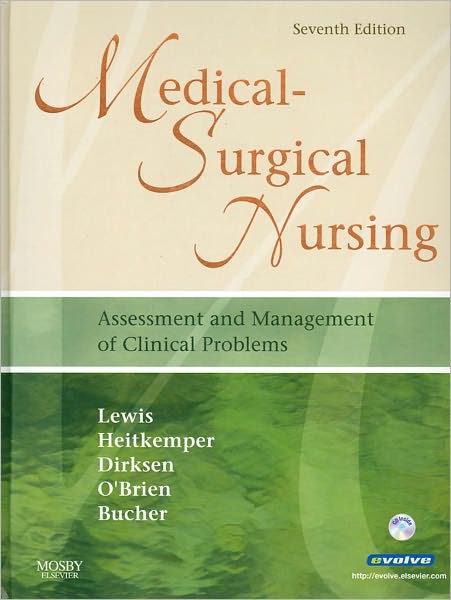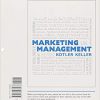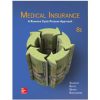Test Bank for Medical-Surgical Nursing, 7th Edition by Lewis
$35.00 Original price was: $35.00.$26.50Current price is: $26.50.
Test Bank for Medical-Surgical Nursing, 7th Edition by Lewis
Instant download Test Bank for Medical-Surgical Nursing, 7th Edition by Lewis pdf docx epub after payment.

Product details:
MULTIPLE CHOICE
1.When the nurse explains to the patient that together they will plan the patient’s care and set goals to achieve by discharge, the patient says, “How is that different from what the doctor does?” Which response by the nurse is most appropriate?
| a. | “The role of the nurse is to provide prescribed patient care.” |
| b. | “The nurse helps the doctor to diagnose and treat patients.” |
| c. | “Nurses perform many of the procedures done by physicians.” |
| d. | “Nursing is focused on the human response to health problems.” |
Correct Answer: D
Rationale: This response is consistent with the American Nursing Association (ANA) definition of nursing, which states that nursing is focused on the human response to health problems. The other responses describe some of the dependent and collaborative functions of the nursing role but do not accurately describe the nurse’s role in the health care system.
Cognitive Level: Comprehension Text Reference: p. 3
Nursing Process: Implementation
NCLEX: Safe and Effective Care Environment
2.When providing patient care using evidence-based practice, the nurse uses
| a. | clinical judgment based on experience. |
| b. | evidence from a clinical research study. |
| c. | evidence-based guidelines coupled with clinical expertise. |
| d. | evaluation of data showing that the patient outcomes are met. |
Correct Answer: C
Rationale: Evidence-based practice (EBP) is use of the best research-based evidence combined with clinician expertise. Clinical judgment based on the nurse’s clinical experience is part of EBP, but clinical decision making should also incorporate current research and research-based guidelines. Evidence from one clinical research study does not provide an adequate substantiation for interventions. Evaluation of patient outcomes is important, but interventions should be based on research from randomized control studies with a large number of subjects.
Cognitive Level: Comprehension Text Reference: p. 5
Nursing Process: Planning
NCLEX: Safe and Effective Care Environment
3.The nurse uses the nursing process in the care of patients primarily
| a. | as a scientific-based process of diagnosing the patient’s health care problems. |
| b. | to establish nursing theory that incorporates the biopsychosocial nature of humans. |
| c. | to explain nursing interventions to other health care professionals. |
| d. | as a problem-solving tool to identify and treat patients’ health care needs. |
Correct Answer: D
Rationale: The nursing process is a problem-solving approach to the identification and treatment of patients’ problems. Diagnosis is only one phase of the nursing process. The primary use of the nursing process is in patient care, not to establish nursing theory or explain nursing interventions to other health care professionals.
Cognitive Level: Comprehension Text Reference: p. 9
Nursing Process: Implementation
NCLEX: Safe and Effective Care Environment
4.An elderly, emaciated patient is admitted to the intensive care unit (ICU). The nurse plans an every-2-hours turning schedule to prevent skin breakdown. In this case, the nursing action is considered to be
| a. | dependent. |
| b. | cooperative. |
| c. | independent. |
| d. | collaborative. |
Correct Answer: D
Rationale: When implementing collaborative nursing actions, the nurse is responsible primarily for monitoring for complications or providing care to prevent or treat complications. Independent nursing actions are focused on health promotion, illness prevention, and patient advocacy. A dependent action would require a physician order to implement. Cooperative nursing functions are not described as one of the formal nursing functions.
Cognitive Level: Application Text Reference: p. 10
Nursing Process: Implementation
NCLEX: Safe and Effective Care Environment
5.A patient who has been admitted to the hospital for gallbladder surgery tells the nurse on admission, “I do not feel right about leaving my children with my neighbor.” During assessment of the patient, an appropriate nursing action by the nurse is to
| a. | reassure the patient that these feelings are common for parents. |
| b. | call the neighbor to determine whether adequate child care is being provided. |
| c. | have the patient call the children to reassure herself that they are doing well. |
| d. | gather more data about the patient’s feelings about the child care arrangements. |
Correct Answer: D
Rationale: The assessment phase includes gathering multidimensional data about the patient. The other nursing actions may be appropriate during the implementation phase (after further assessment of the patient’s concerns is accomplished by the nurse), but they are not part of the assessment phase.
Cognitive Level: Application Text Reference: p. 10
Nursing Process: Assessment NCLEX: Psychosocial Integrity
6.A patient with a stroke is paralyzed on the left side of the body and is not responsive enough to turn or move independently in bed. A pressure ulcer has developed on the patient’s left hip. The best nursing diagnosis for this patient is
| a. | impaired physical mobility related to paralysis. |
| b. | impaired skin integrity related to altered circulation and pressure. |
| c. | risk for impaired tissue integrity related to impaired physical mobility. |
| d. | ineffective tissue perfusion related to inability to turn and move self in bed. |
Correct Answer: B
Rationale: The patient’s major problem is the impaired skin integrity as demonstrated by the presence of a pressure ulcer. The nurse is able to treat the cause of altered circulation and pressure by frequently repositioning the patient. Although impaired physical mobility is a problem for the patient, the nurse cannot treat the paralysis. The “risk for” diagnosis is not appropriate for this patient, who already has impaired tissue integrity. The patient does have ineffective tissue perfusion, but the impaired skin integrity diagnosis indicates more clearly what the health problem is.
Cognitive Level: Application Text Reference: p. 11
Nursing Process: Diagnosis NCLEX: Physiological Integrity
7.A patient with an infection has a nursing diagnosis of fluid volume deficit related to excessive diaphoresis. An appropriate patient outcome identified by the nurse is that the
| a. | patient has a balanced intake and output. |
| b. | patient understands the need for increased fluid intake. |
| c. | patient’s bedding is changed when it becomes damp. |
| d. | patient’s skin remains cool and dry throughout hospitalization. |
Correct Answer: A
Rationale: This statement gives measurable data showing resolution of the problem of fluid volume deficit that was identified in the nursing diagnosis statement. The other statements would not indicate that the problem of fluid-volume deficit was resolved.
Cognitive Level: Application Text Reference: p. 13
Nursing Process: Planning NCLEX: Physiological Integrity
8.A patient has a nursing diagnosis of activity intolerance related to prolonged bed rest as manifested by the patient’s report of weakness and fatigue. An appropriate NOC outcome and NIC intervention for this nursing diagnosis would be
| a. | Activity Tolerance (NOC) and Activity Therapy (NIC). |
| b. | Endurance (NOC) and Body Mechanics Promotion (NIC). |
| c. | Energy Conservation (NOC) and Sleep Enhancement (NIC). |
| d. | Energy Conservation (NOC) and Exercise Therapy: Balance (NIC). |
Correct Answer: A
Rationale: The outcome and intervention in this response correspond closely to the nursing diagnosis of activity intolerance related to prolonged bed rest. The other outcomes and interventions do not directly address this nursing diagnosis.
Cognitive Level: Analysis Text Reference: pp. 12-14
Nursing Process: Planning
NCLEX: Safe and Effective Care Environment
9.The nurse reads on the care plan that a patient is at risk for developing an infection. The nurse recognizes that this patient problem
| a. | is always a nursing diagnosis. |
| b. | is always a collaborative problem. |
| c. | could be either a nursing diagnosis or a collaborative problem, depending on the cause of the problem. |
| d. | should not be included on the care plan because nursing actions routinely protect patients from infection. |
Correct Answer: C
Rationale: If the source of the risk for infection is something that can be treated by nursing, then the problem is a nursing diagnosis. If it is one that requires treatment by other health care providers, the problem is collaborative. In either case, the risk for infection should be included in the care plan.
Cognitive Level: Comprehension Text Reference: pp. 10, 12
Nursing Process: Diagnosis NCLEX: Physiological Integrity
10.A nursing activity that is carried out during the evaluation phase of the nursing process is
| a. | documenting the nursing care plan in the progress notes. |
| b. | asking whether the patient’s health problems have been completely resolved. |
| c. | determining the effectiveness of nursing interventions toward meeting patient outcomes. |
| d. | asking the patient to evaluate whether the nursing care provided was satisfactory. |
Correct Answer: C
Rationale: Evaluation consists of determining whether the desired patient outcomes have been met and whether the nursing interventions were appropriate. The other responses do not describe the evaluation phase.
Cognitive Level: Comprehension Text Reference: p. 15
Nursing Process: Evaluation
NCLEX: Safe and Effective Care Environment
11.During the assessment phase of the nursing process, the nurse
| a. | obtains data with which to diagnose patient problems. |
| b. | teaches interventions to relieve patient health problems. |
| c. | uses patient data to develop priority nursing diagnoses. |
| d. | helps the patient identify realistic outcomes to health problems. |
Correct Answer: A
Rationale: During the assessment phase, the nurse gathers information about the patient. The other responses are examples of the intervention, diagnosis, and planning phases of the nursing process.
Cognitive Level: Knowledge Text Reference: p. 10
Nursing Process: Assessment
NCLEX: Safe and Effective Care Environment
12.An example of a correctly written nursing diagnosis statement is
| a. | altered tissue perfusion related to heart failure. |
| b. | ineffective coping related to response to biopsy test results. |
| c. | altered urinary elimination related to urinary tract infection. |
| d. | risk for impaired tissue integrity related to sacral redness. |
Correct Answer: B
Rationale: This diagnosis statement includes a NANDA nursing diagnosis and an etiology that describes a patient’s response to a health problem and can be treated by nursing. The use of a medical diagnosis (as in the responses beginning “Altered tissue perfusion” and “Altered urinary elimination”) is not appropriate. The response beginning “Risk for impaired tissue integrity” uses the defining characteristics as the etiology.
Cognitive Level: Comprehension Text Reference: p. 11
Nursing Process: Diagnosis
NCLEX: Safe and Effective Care Environment
13.The nurse writes a complete nursing diagnosis statement by including
| a. | a problem, its cause, and objective data that support the problem. |
| b. | a problem with all its possible causes and the planned interventions. |
| c. | a problem and the suggested patient goals or outcomes. |
| d. | a problem with its etiology and the signs and symptoms of the problem. |
Correct Answer: D
Rationale: The PES format is used when writing nursing diagnoses. The subjective, as well as objective, data should be included in the defining characteristics. Interventions and outcomes are not included in the nursing diagnosis statement.
Cognitive Level: Knowledge Text Reference: p. 11
Nursing Process: Diagnosis
NCLEX: Safe and Effective Care Environment
14.Which of these tasks is appropriate for the registered nurse to delegate to a licensed practical nurse?
| a. | Documenting patient teaching about a routine surgical procedure |
| b. | Administering an oral pain medication to a patient |
| c. | Teaching a patient how to self-administer insulin |
| d. | Completing the initial admission assessment and plan of care |
Correct Answer: B
Rationale: The education and scope of practice of the LPN/LVN include administration of oral medications. Patient teaching and the initial assessment and development of the plan of care are nursing actions that require RN-level education and scope of practice.
Cognitive Level: Application Text Reference: p. 15
Nursing Process: Planning
NCLEX: Safe and Effective Care Environment
Related products
Test Bank
Test Bank for Essentials of Business Law and the Legal Environment, 11th Edition: Richard A. Mann











